Photography Tips
by Michael Frye | Oct 27, 2013 | Advanced Techniques, Photography Tips
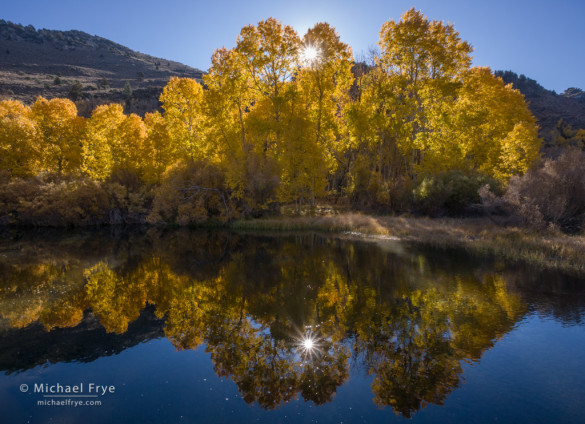
Aspens and morning sunlight, Inyo NF, CA, USA
I’ve always felt that the best photographs capture a mood or feeling. It’s easier to convey a mood when the weather gets stormy, but how do you capture a mood on a clear, sunny day? The answer, I think, is to go with it—to emphasize the sun, the blue sky, and the brightness of the day. Find the visual elements that say “beautiful, sunny day,” and highlight them.
One way of doing this is to include the sun in the frame. Nothing says “sunny and bright” like the sun itself. But putting the sun in your photograph brings challenges. First, you’re likely to get lens flare. This is not the end of the world—in fact, many photographs use lens flare to great effect—but sometimes the flare can be distracting. The other challenge is getting the exposure right.
(more…)
by Michael Frye | Oct 13, 2013 | Photography Tips
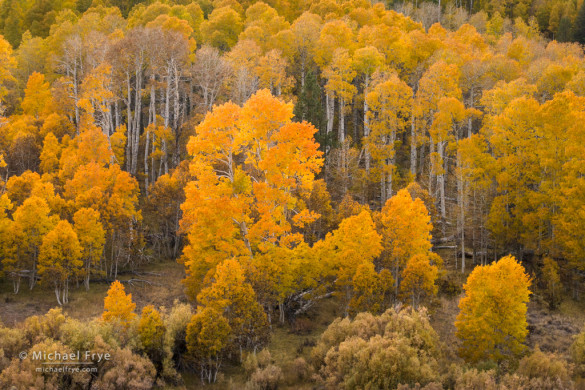
Autumn aspens, Conway Summit, Inyo NF, CA, USA
Here are two photographs I made last week near Conway Summit on the eastern side of the Sierra. The first one, above, is from Tuesday afternoon, with soft backlight filtering through thin clouds and making the leaves glow. The second image, below, was made Wednesday morning under overcast skies as the snow started to fall. I used a fast shutter speed (1/90th sec.) to freeze the motion of the snowflakes, which created a faint white dot pattern across the frame.
(more…)
by Michael Frye | Aug 6, 2013 | Light and Weather, Photography Tips, Vision and Creativity
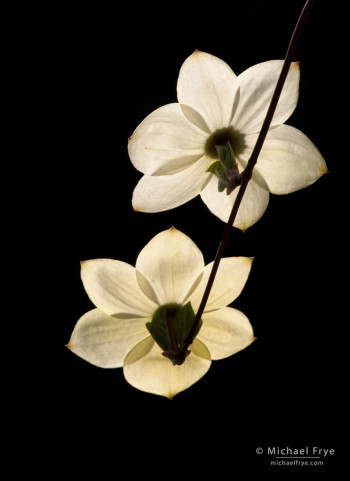
Dogwood blossoms, Yosemite. These backlit flowers stand out cleanly against a dark, shaded background.
Light Against Dark
Many of the most effective photographs share a simple lighting concept: they either place a light subject against a dark background, or a dark subject against a light background.
This first photograph of two dogwood blossoms is a perfect example of a light subject against a dark background. In fact the background isn’t just dark; it’s completely black, so there’s nothing to compete visually with the flowers. The contrast creates a simple and dramatic image.
This light-against-dark situation is what makes photographs of Horsetail Fall so striking when conditions are right. The waterfall stands out because it’s brighter than the surrounding cliffs – and, of course, because of the color.
(more…)
by Michael Frye | Jul 23, 2013 | Light and Weather, Photography Tips, Vision and Creativity
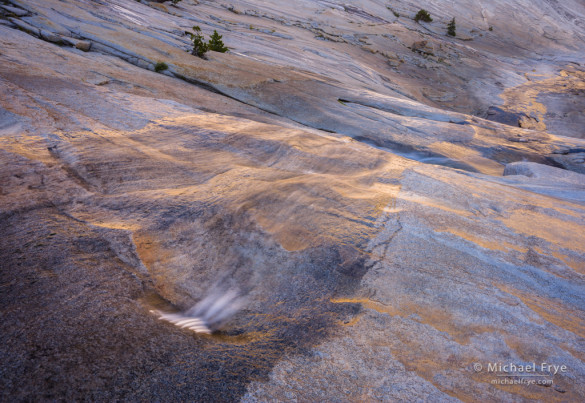
Creek descending through a granite basin. The sun was hitting the rocks just beyond the top of the frame, reflecting the gold color into the water, and even onto some of the polished rocks on the right.
When people think of photographing a reflection, they usually think of a mirror reflection, like a mountain reflected in a tranquil lake. I’ve done my share of those, but I think it’s often more interesting to just look at the colors, textures, and patterns on the water’s surface.
During my just-completed Hidden Yosemite workshop we had many opportunities to photograph reflections of all kinds. The accompanying photographs represent a mini-gallery of reflection photographs that I made during and just prior to the workshop, with extended captions to explain the thought process behind each image. Most of these are not mirror reflections; instead, they’re focused on the water’s colors and textures.
(more…)
by Michael Frye | Jul 10, 2013 | Composition, Photography Tips, Vision and Creativity
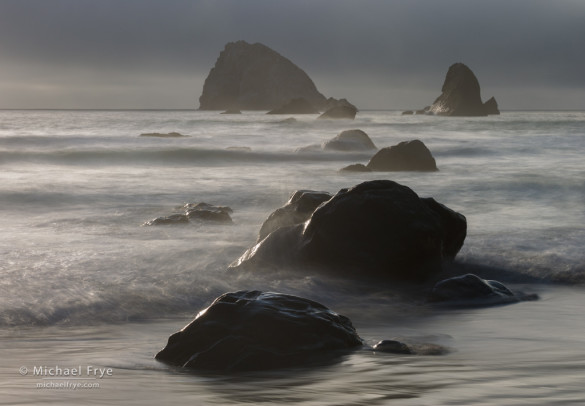
Rocks and sea stacks, late afternoon, Redwood NP, CA, USA
Spacing and separation are always important elements of composition, but during my recent workshops in and around Redwood National Park we encountered many situations where spacing and separation were particularly vital.
The photograph above is a good example. I positioned the camera carefully to avoid, as much as possible, visual mergers between the foreground rocks. I wanted the shape of each rock to stand out clearly, as those shapes are the point of this composition: they set up a repeating pattern, and lead your eye from foreground to background.
(more…)
by Michael Frye | Sep 27, 2012 | Advanced Techniques, Night Photography, Photography Tips
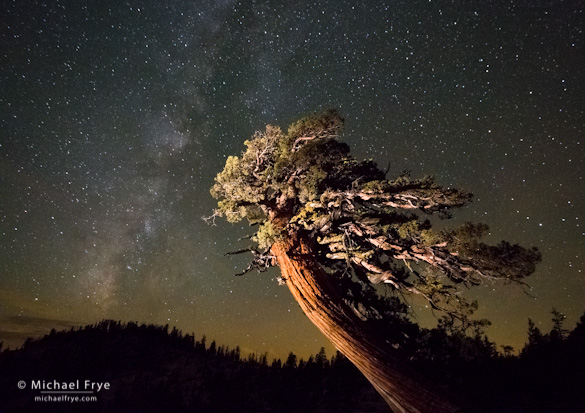
Sierra juniper and the Milky Way, Olmsted Point, Yosemite
Gear Doesn’t Matter—Except When it Does
Regular readers know that I’m not much of an equipment geek. It’s not that I don’t think equipment is important—a photographer needs good tools. It’s just that I think light, composition, technique, vision, and imagination are more important. In other words, how you use the tools is more important than what tools you use.
But sometimes the right gear can make a difference. Two weeks ago I was recording video segments for some online courses I’m working on (more about that later!), and needed a digital SLR that could record video—something my trusty old Canon 1Ds Mark II can’t do—for some “through-the-lens” views. So I called up my friend Jim Goldstein. Many of you know Jim through his popular blog and social media streams. Jim also works for Borrowlenses.com, and he set me up with a Canon 5D Mark III for my video shoot, and then asked, “Is there anything else you need?” Hmm… well I’ve been wanting to test the Canon 24mm f/1.4L lens for night photos, so yes, there was something else!
(more…)














